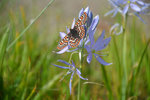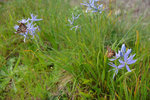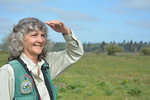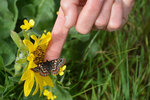



The scientists at the Washington State Department of Fish and Wildlife have successfully reintroduced the endangered Taylor’s checkerspot butterfly into South Sound prairies, specifically at the Scatter Creek Wildlife Area in Thurston County and Joint Base Lewis McChord.
Biologists were out on one of the Scatter Creek sites near Rochester Wednesday counting the number of the butterflies along survey lines and were pleased to see that “there were almost too many to count,” said Mary Linders, endangered species recovery biologist for WDFW.
In the past decade, WDFW has tripled the number of Taylor’s checkerspot butterflies in the South Sound prairies.
“No one has been able to do this successfully with this group of butterflies, so this is really exciting on a national scale,” Linders said.
Taylor’s checkerspot butterfly is one of about 20 subspecies of Edith’s checkerspot butterfly, and is the only one that has successfully been reintroduced to the wild.
The butterfly became endangered due to loss of habitat from the advance of invasive plant species like Scotch broom. So the first method of restoring the subspecies was to restore the prairies themselves.
Josh Cook, wildlife biologist for WDFW, specializes in prairie restoration and said WDFW has a suite of treatments it does every year to help restore the habitat for Taylor’s checkerspot butterflies.
“The easiest way to do it is to start with prescribed fire,” he said. “We’ll select areas that could use a burn and that will open up a canvas, essentially, of landscape. Then the invasive weeds will emerge first, once we get some precipitation. So we’ll herbicide those out, and that will give us the opportunity to select against them. A lot of the native plants will emerge after that.”
Those native plants are what the Taylor’s checkerspot butterfly needs to survive. These plants include the blue camas and Indian paintbrushes found in the prairies.
“Over the course of the last 20 years, we’ve been working hard on restoring the habitat on this prairie,” Linders said. “It used to be covered with scotch broom, five, six, seven feet tall. We have gotten rid of that and are restoring a lot of the native prairie plants. These efforts preserve a lot of the native nectar and host plants for the Taylor’s checkerspot butterfly, and also for a whole suite of other species that are also very rare on these prairies.”
In 2007, WDFW officially started the program, testing the waters of this type of restoration work. The larva were reared in captivity throughout their hibernation stage, before the caterpillars could be released onto the prairies.
Linders said it is important to note that researchers in the Bay Area of California have studied a different subspecies of the same butterfly for 40 years, but have not been able to get the larva through the hibernation stage of the growth process. WDFW biologists have done so in just over a decade of work.
“We started playing with smaller numbers,” Linders said. “We were captive rearing at the Oregon Zoo, trying to figure out how to captive rear, just putting out a few hundred caterpillars into the prairies at a time.”
The program also captive rears the larva at Mission Creek Corrections Center for Women in Belfair, Washington.
Over the years, as they pinpointed the exact life stage to release the caterpillars, biologists at WDFW felt comfortable releasing them in progressively larger numbers.
During the five years that led up to 2013, WDFW released anywhere from 1,500 to 2,500 per year on prairie sites around the south sound area.
“We did our last release, for the most part, in 2013,” Linders said. “We did sort of one bump up in 2016 because we were concerned about a big El Nino year that might take that population back down. The numbers are quite precarious until they get into the thousands.”
The results have been better than anyone could have expected as she and others at WDFW monitor the population growth with regular surveys, Linders said.
“Now for the last three years the numbers of adults have been building really quickly,” she said. “And so we are kind of seeing exponential growth in the population right now. We are probably hitting maximum density, so we are kicking butterflies out into the surrounding habitat, which is really exciting for us… They are shooting out all over the place.”
Taylor’s checkerspot butterfly is an integral part of the prairie system. Just as the prairies support its life, it supports the life of the prairies. It is all a delicate balance, Linders said, with plenty of problems to work through.
“We often look at a single species and say, ‘Why do we need that one?’” she said. “In the case of these prairies, it’s not just one species that we are concerned about. In fact, one of the things we are seeing with the restoration of the Taylor’s checkerspot is … it’s actually creating and maintaining habitat for a whole host of other birds, butterflies, rare plants.”
Linders said that this line of work is her calling and that she loves how these prairies are why European settlers built here in the first place, and how they have historically been integral to the way of life for many Native Americans.
Restoring the prairies, then, has become a priority in her life.
“I don’t know what else I would do,” Linders said. “I absolutely love what I do. It’s work that takes passion and takes commitment. It’s something that really requires me to put all my physical and mental capacities to try to solve these problems. This particular butterfly seems to be too complex to research our way through these problems.”
Linders and company at WDFW have had to act and invest in the prairies to obtain the results they have accomplished.
So be on the lookout for an orange and black butterfly in prairie land, because it’s a sight that was seldom seen 10 years ago.